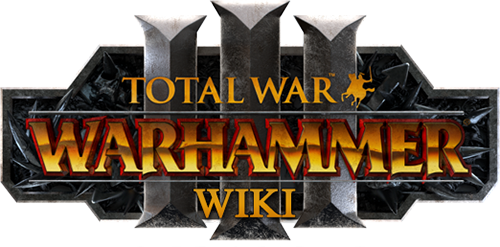| “ | Though not noble or powerful like Knights, these men take great honour to take up arms in defence of home. | „ |
Men-at-Arms (Polearm) are a ![]() Bretonnia melee infantry unit introduced in Total War: Warhammer with Bretonnia (DLC).
Bretonnia melee infantry unit introduced in Total War: Warhammer with Bretonnia (DLC).
Recruitment[ | ]
 Unlocked with: Barracks
Unlocked with: Barracks
Description[ | ]
Each Midsummer, commoners flock to their Lord's castle to present their sons in the hope that they will be trained as Men-at-Arms. For a peasant to have a son accepted into the ranks of a Knight's household is a great honour. Some young peasants will have been guided towards this goal through their entire life, encouraged to stand up straighter and taller than the usual peasant 'slouch' to better improve their chances of selection. All morning and afternoon the Knight inspects the candidates. By dusk, the luckiest and strongest are selected and are taken back to the castle where they are given basic training and outfitted in the livery of their Lord.
Attributes[ | ]
 Halberd Infantry
Halberd Infantry- ▲ Armour-Piercing: The damage of
 armour-piercing weapons mostly ignores the armour of the target, making them the ideal choice against heavily-armoured enemies. They are often heavier and attack at a slower rate though, making them less efficient against poorly-armoured targets.
armour-piercing weapons mostly ignores the armour of the target, making them the ideal choice against heavily-armoured enemies. They are often heavier and attack at a slower rate though, making them less efficient against poorly-armoured targets. - ▲ Anti-Large: Anti-Large: Anti-large units have an advantage against targets that are at least as large as a horse. This advantage can be a
 damage bonus against large targets or an attack that focuses on a very small area. However, some units are simply better against large targets because their attacks are slow and easy to dodge by skilled melee combatants.
damage bonus against large targets or an attack that focuses on a very small area. However, some units are simply better against large targets because their attacks are slow and easy to dodge by skilled melee combatants. - ▲ Charge Defence Against All: When standing and bracing against a charge this unit will negate the enemy's
 charge bonus.
charge bonus. - ▲ Expendable: This unit is comparably cheap to recruit, maintain and replenish.
Strategy[ | ]
Men-at-Arms (Polearm) are mid-tier infantry belonging to what is almost universally acknowledged as the weakest-infantry race in the entire Warhammer Total War trilogy. As Bretonnia's mid-tier infantry, these units are weaker on their own than many other races' low-tier infantry.
Despite this, Men-at-Arms (Polearm) are not completely useless, especially on low-to-mid battle difficulty settings. They are cheap, armour-piercing, (relatively) high melee defense infantry designed for one real purpose: hold the line just long enough for Bretonnia's powerful cavalry to crush the enemy from behind! For this, they are adequate, which is all they need to be. When their leadership is buffed by a Grail Reliquae (a near-necessity) and/or a nearby lord, and especially if supported by life magic (see below), they perform surprisingly well relative to their very inexpensive cost. Due to their anti-large bonus and armour-piercing, it is even quite possible for them to "punch up" and dish out a little bit of damage against what are often very dangerous enemy units much more expensive than themselves. When well-supported, they are even able to route dangerous low-leadership units like Trolls. In addition, when a Bretonnian army earns the Blessing of the Lady, Men-at-Arms units are able to hold the line just that much longer with the 15% ward save bonus.
In regard to the use of life magic in a Bretonnian battle, one might assume that any winds of magic used on Peasant units is a complete waste and should be saved for the much more valuable Knights. This is true to a degree, but it is not so simple. Consider that: 1) Knight units have a much lower unit count with much higher-health models compared to Peasants, 2) The primary healing spell of life magic is LifeBlood, which is a very inexpensive spell with a very fast cooldown, 3) Bretonnia often has an ample supply of Winds of Magic, and 4) The much faster, higher-mass Knights can easily get away from most threats to be healed later on. These factors combined mean it can often be very useful to cast a few LifeBloods on a Peasant frontline early in a battle, giving them just a few moments of extra staying power. This gives the Knights, who have likely not lost many models in the early stages of a battle, just a little bit of extra time to get into position for the most effective possible charges. Once Knights have entered heavy combat and begin losing significant health, all healing resources should be directed fully at them before they start taking heavy casualties. But before that, just a little bit of frontline healing can make the difference between a battle won or an all-out route.
Hypothetically, it is always better to build Bretonnian armies composed of 100% cavalry. But, due to the very high expense (and, for those players who value lore and believability, immersion-breaking nature) of such armies, throwing in a few Polearms supported by a Reliquae remains a decent option for saving some money, and often prove extremely useful as distraction or chaff. In addition, they can also be very useful for protecting Field Trebuchets or the usefully de-buffing Pox Archers while your extremely mobile cavalry run around the battlefield dishing out all the real damage.
Because the Polearm version of Men-at-Arms do not have shields, they should avoid enemy missile units if at all possible.
| ||||||||||||||||||||||||||||||||||||||||||||||||||||||
